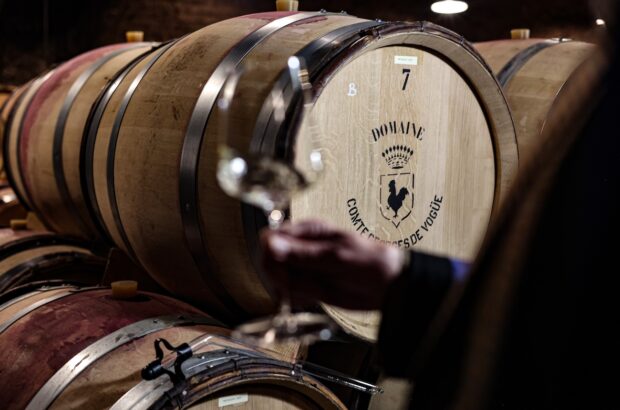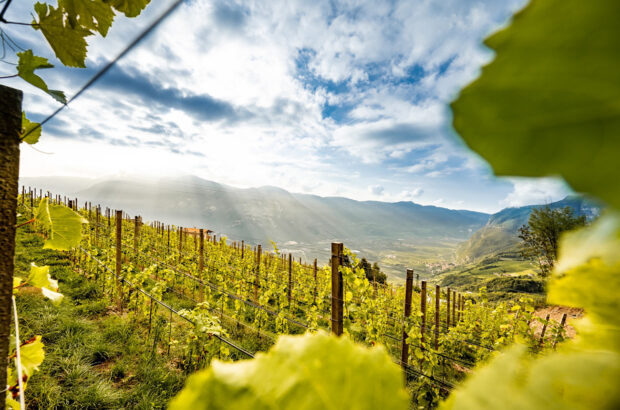When an insect that had gone unnoticed in the US arrived in France in the 19th century on some vine cuttings, it almost destroyed the world’s vineyards from the roots up. CHRISTY CAMPBELL looks at the rise and rise of the phylloxera aphid
HOW DO YOU turn the greatest disaster in the history of wine into a festival of love? In the little town of Roquemaure perched on the banks of the lower Rhône valley, the shrewd citizens have done just that. Inspired by their ingenious parish curé, for the past 20 years this sleepy town in southeast France has declared itself, each 14 February, to be the world capital of romance. Every year the relics of St Valentine are reverently removed from the medieval church and paraded through the square.
But just why the bones of the patron saint of lovers (they are encased in a suitably kitsch porcelain doll) should have ended up here is a less than romantic story. I found out for myself when I visited this agreeable wine-growing corner of the Gard in search not of love, but of an insect.
For this is where a great biological catastrophe began. Its cause was a tiny parasitic aphid. It has had various scientific names since it was identifed almost a century and half ago by an entomologist in New York state. But wine growers ever since have known their mortal enemy simply as the ‘phylloxera’.
Like most people with an interest in wine, I had vaguely heard of it. Wasn’t it something to do with America? Weren’t the vineyards of France and later most of the wine-growing world dug up and remade somehow with vines from the New World? The truth was much more complicated than that.
My own journey of discovery had begun in the library of the Royal Botanic Gardens at Kew. I found letters dating from the early 1870s from a French botanist named Jules-Emile Planchon to Dr Joseph Hooker, director of Kew (where Planchon had studied as a young man), describing an ‘unknown’ disease afflicting vines.
The letters pointed to Roquemaure as the possible site of the first outbreak.
Hence my visit.
Documents in local archives confirmed the finding. A modest vine-grower named Monsieur Borty had planted exotic vines a decade earlier in the walled vineyard behind his house. They had been sent in a sealed parcel across the Atlantic by a ‘friend’ in New York. Something had travelled with them.
Three years later, in the summer of 1865, vines in surrounding villages mysteriously began to wither and die. The affliction would typically begin in the centre of a vineyard, spreading outwards like an ‘oil-spot’. M Borty, meanwhile, found that although his American vines were prospering, his native varieties were dying in droves.
When a dead vine was dug up its roots were rotting. There was no apparent cause. The plague spread. It ‘slept in the autumn and re-awoke the next spring’, according to perplexed vignerons – who saw its depredations as a judgement of God. Thus it was in 1868 that a benevolent local merchant obtained from Rome holy relics of St Valentine to bear through the vineyards and ward off the evil. Alas the move was not successful.
It was then that J-E Planchon arrived from Montpellier in the neighbouring l’Herault to investigate. He dug up a vine in the first stage of decline (no one had yet thought to dig up a healthy one) and observed its roots encrusted with a mass of minute yellow insects. The villain was revealed. He called it ‘phylloxera vastatrix’ – the dry leaf devastator.
Nothing seemed to stop it. Primitive insecticides proved expensive and dangerous. As the infection advanced only the grandest could afford chemicals. It seemed that the vast vine culture of the Midi, the Mediterannean south, churning out wine for the thirsty cities of the north, would be obliterated. The government offered a prize of 300,000 gold francs for a practical remedy. It was wine that was at stake, after all – the very soul of France.
Planchon laboured in his laboratory. He observed how generations of female phylloxera (no male had been identified) could reproduce asexually, bearing millions of offspring in a summer season. In captivity a winged form appeared. Perhaps that was how they spread. They had one source of nutrition – the roots of the grapevine, sucking the sap until the vine began to die and they moved on in search of fresh roots.
Where had the horrible aphid come from? Planchon was as perplexed as anyone. There followed one of the greatest detective stories in the history of science.
The sex life of the phylloxera baffled scientists. In the multiple life-stages of the leaf-living insect there is a single, mouthless, anusless male form, existing for a few days solely to service the so-called ‘fundatrix’ mother.
The provincial botanist began to suspect that the insect had been somehow accidentally imported from America. There was mention in recent scientific literature of an insect that made harmless galls in the leaves of American vines, but nothing about one that attacked their roots. He crossed the Atlantic himself in 1873 to find out more – to Missouri – where a fledgling wine industry had been established using cultivated native American vine species. There he met the English-born entomologist Charles Riley, who had identified the leaf-living form of the bug. When they compared it with the root-suckers from the Midi, they were the same. All doubts were gone when, in 1874, M Borty’s widow confessed to Planchon her late husband’s secret.
The botanist began to understand, in an object lesson in the then still highly controversial theories of Charles Darwin, that evolution had programmed the parasite and its American hosts to live together. Their roots were ‘resistant’ – the insect preferred living harmlessly enough on their leaves. The European vine species, Vitis vinifera, had no natural defence. Once accidentally transplanted, the aphid fell on the underground feast until it seemed there would be no vines left to consume.
A BAD TASTE
There appeared to be a simple solution – import American vines and start again. Millions of Missouri-made vine cuttings were shipped to France. But as they came to maturity a new disaster dawned. It was tragi-comic to read old papers in the University of Montpellier’s library, recording the judgements on blind tastings.
‘American’ wines had a strange undertaste. The more polite called it ‘raspberry’. The more direct called it pissat de renard (fox piss). No true Frenchman would drink it.
There must be another solution. The prize offer, meanwhile, had brought forth a torrent of mad proposals – steam, ice, moles or chickens would defeat the aphid. (The prize was never awarded.) Scientists were split between those who put their faith in chemical insecticide and those like Planchon, who struggled on with American vines.
The Government backed the chemists, and troops were called out to enforce the application of insecticide. The plague looked unstoppable. By the early 1880s, despairing vignerons were laying down their last vintages, convinced it was the end. Thousands left for Algeria or Chile to start again. The Médoc succumbed, then Burgundy. The last citadel to fall was Champagne, far to the north on its raft of chalk. When the invaders reached the Marne in 1894, church bells were rung in alarm.
But there was a solution – and you don’t have to be an expert to understand it. Different species of vines can be ‘hybridised’ – artificially crossed to impart some of the parents’ characteristics. But more importantly, they can be grafted, spliced together from two different species to make a compound organism whose leaves and roots are genetically quite seperate.
French wine growers discovered something amazing. American ‘rootstock’ beat the underground bug. Splice a variety of vinifera onto it and it would bear fruit as untainted as that which had gone before. Scientists developed hybrid rootstock which would work efficiently in different soils. Finding one that would work in chalk took decades of research. Many are still in use today.
At last the ‘taste of fox’ was run to earth. There were plenty who disagreed – but when the grandest houses of Beaune and Bordeaux put their faith in grafting, the intellectual battle was won.
But the old ways of winemaking were being extinguished forever. Grafted vines need more intensive labour and big doses of fertiliser. Peasant vignerons who could not afford the new ‘scientific’ viticulture came down from their hilltops to become hired labourers on the plains.
The bug spread round the world. California (where ‘European’ vines had been grown for centuries) succumbed when the aphid crossed the Rocky Mountains. It reached South Africa and Australia and by 1900 the phylloxera reigned across Europe from the Douro Valley to the Crimea.
‘Reconstitution’ with grafted vines was the global solution and has been so ever since. Semi-resistant American-vinifera hybrid vines, grown in France as a cheap and cheerful solution, were at last abandoned in the 1970s.
The catastrophe that began at Roquemaure so long ago still shapes modern winemaking absolutely. Wherever there are vines, phylloxera lurks in malign attendance. Scientifically managed grafting remains the first line of defence. But things can go wrong. Phylloxera ripped through California in the early 1990s when a recommended hybrid rootstock proved vulnerable to a voracious new strain of the aphid. It was proposed, amid general uproar, that genetic modification might be the only way of beating the bug forever.
There are, however, pockets of vines that have always grown franc de pied as the French say. In Champagne a few plots of ungrafted Pinot Noir mysteriously did not succumb. The Bollinger family has preserved them ever since – to make its unique ‘Vieilles Vignes Françaises’ described by the house as, ‘the living relic of what Champagne was a century ago, before phylloxera destroyed the vineyards of France.’
The clever marketeers of Chilean wine expound a simple geographical lesson. The country, biologically sealed by the Atacama desert in the north and icy Patagonia in the south, never admitted the aphid.
Commercial, own-rooted vinifera vineyards have survived in Portugal, Cyprus, southern Australia, parts of New South Wales and California, and in much of Russia. Tap in ‘pre-phylloxera’ on an internet search and some most unusual offerings will appear.
Is there a difference in the taste? The debate has rumbled for a century.
When in April 2000 Château Latour brought an 1863 wine to a set-piece auction at Christie’s in New York, the critic of Wine Spectator swooned: ‘I have tasted pre-phylloxera wines a dozen or so times in my life, and they never cease to astonish with their purity and clarity on the nose and palate…’ The experience cost almost $5,000.
Next time a humbler glass is raised, think of those wine growers and scientists of the Midi who a century and a quarter ago began to put the vineyards of France back together again. Without them wine might be beyond anyone’s price.
Christy Campbell is the author of Phylloxera: How Wine was saved for the world, £17.99, Harper Collins.
Written by Christy Campbell






